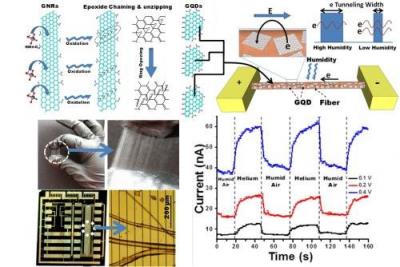Researchers from Kansas State University developed improved electron-tunneling based humidity, pressure or temperature sensing devices using graphene quantum dots. Those devices are more responsive in vacuum compared to most sensors. They will be able to detect trace amounts of water on Mars, for example.

To create the Quantum Dots, the researchers used nanoscale graphite cuttings to produce graphene nanoribbons. Chemically cleaving those ribbons into 100 nanometer sized pieces created the quantum dots.
Those QDs where then assembled into a network on a hyroscopic microfiber which was attached to electrodes. The QDs were not connected (they are a nanometer apart) but when humidity is present, the fiber shrinks and so the QDs get closer to each other - which increases the electron transport. This actually create a humidity sensor.